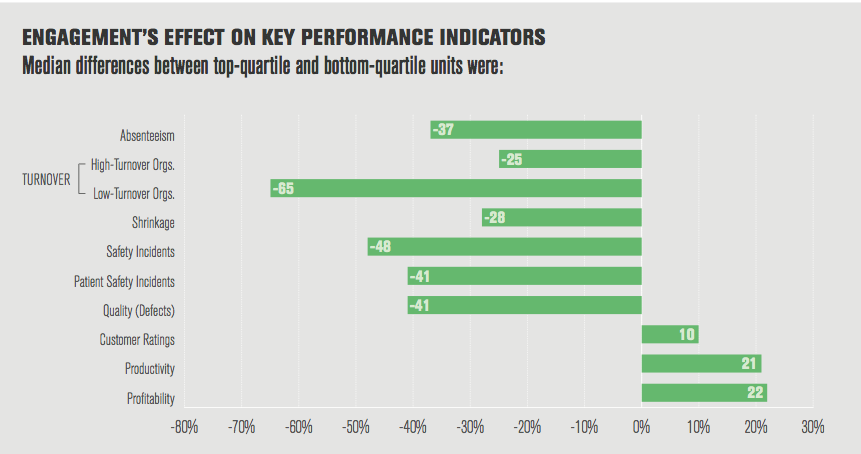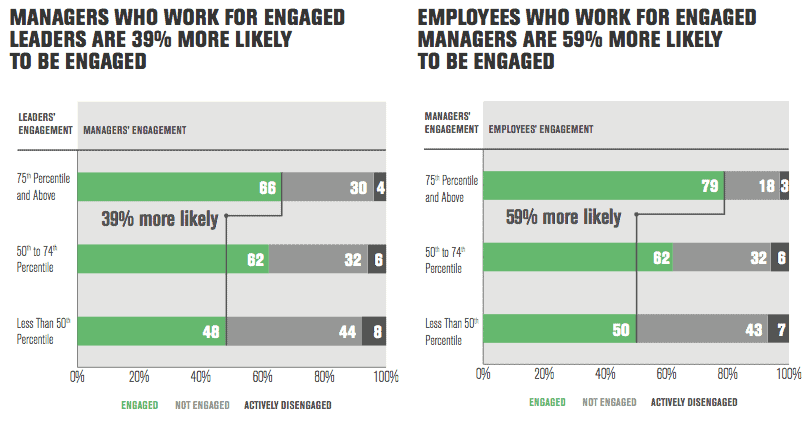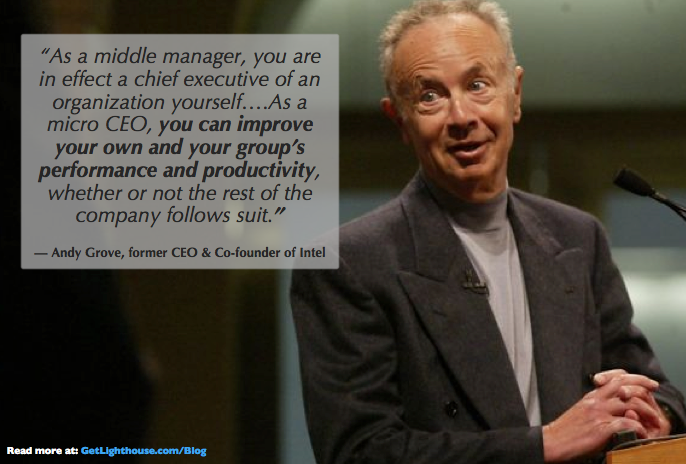“People leave managers, not companies.”
You’ve probably heard that phrase over the years, and if you’ve managed for long, you’ve probably felt it.
Whether you’ve quit a manager, or you lost someone on your team due to your actions or inaction, it hurts to lose good people.
Becoming a leader is a major career change
No matter what your individual contributor (IC) role was before, it’s a huge change to be in charge of leading, motivating, and keeping a team of people busy.
Yet, too often you’re left to figure it out on your own:
- Your manager who promoted you is busier than ever
- They may or may not be a good example of what to do
- You didn’t major in being a manager
Is it any surprise a lot of managers make mistakes that cost them good people on their teams?
Today, we want to show you why leadership training is important, as well as the purpose and benefits of training. This will help you consider what you can do on your own, as well as strategies for thinking about training your group, department, or entire company.
Whether you need to be convinced to make the investment, or you’re looking for help to convince others to do so, this post is here to help you.
Here's what we'll be covering:
- The Hidden Costs of Ignoring Leadership Training
- The Real Impact of Effective Leadership Training
- Pick the right Leadership training for All of Your Levels of Leaders

1) The Hidden Costs of Ignoring Leadership Training
One of the hard things about management is that you can't quantify it easily. Unlike sales, where it's easy to tell how many dollars were made and who closed the deal, the cost of having poor leaders is harder to notice.
Let's take a look at the two largest hidden costs that stem from ignoring the importance of leadership training.
Hidden Cost #1: High Employee Turnover
One of the biggest costs of having poor leaders is having high employee turnover. Poorly trained managers often struggle to effectively support and develop their teams. This leads to people quitting.
And when one person quits, it can often lead to a wave of people quitting. It adds up fast.
Remember, as we said in the introduction, people leave managers not companies; that means when there's turnover, it's probably on you, or the manager the person reported to.
You may think that's just a folk saying or a work urban legend that doesn't have any data to back it up. But it turns out that there is.
Gallup's chief scientist, James Harper, has stated that at least 75% of employees voluntarily leave their jobs due to poor management. And of course, that also contributes to disengagement, which we'll talk about later.
Furthermore, Gallup and their State of the American Manager report found that 50% of Americans have left a job explicitly to "get away from their manager" at some point in their career.
So a definite expensive thing that many untrained and poorly trained leaders have had to deal with is employee turnover.
If you don't invest and train your leaders, don't be surprised if they do exactly the kinds of things that cause people to quit.
Hidden Cost #2: Low Morale and Disengagement
Turnover isn't your only problem. Sometimes people stay, and that can be just as bad.
Low morale and disengaged employees are the second most expensive and measurable cost of under-trained managers.
Without strong leadership, it's easy for your team members to become increasingly disinterested and unmotivated. Even worse, it can spread; even people who are generally happy or fine at work can get dragged down by those who are unhappy or checked out.
And this disengagement is very costly to you and your company.

Gallup's research shows that disengaged employees are about 20% less productive, and their teams are approximately 20% less profitable than their engaged counterparts.
That leaves a lot of quality work and productivity on the table.
And this disengagement and turnover is largely the manager's fault.
Gallup has studied and surveyed millions of managers, and they concluded that at least 70% of the variance in employee engagement is caused by the manager. This means whether your team has a bunch of people quitting, or the more common early signal of low morale and employees checking out, it will get very expensive, very fast.
Checked out employees don't get as much work done, and they can actually cause other people to become disengaged as well as their poor attitude and slower work pace becomes contagious.
Further reading:
To dive deeper into how managers contribute to low morale, and proven steps to motivate a disengaged team, be sure to check these two posts:
An important lesson: If they’re not growing, they might be going…
You also need to keep in mind that if your people aren't growing, they might be thinking about leaving.
The Work Institute has been putting out a retention report for over a decade. And in their 2023 report, they reported the top two reasons for people quitting:
- Career: Opportunities for growth, promotion, achievement, security, or to attend school
- Job: Stress, availability of resources, training, job characteristics, empowerment, or products
Most notably, career growth has been the top reason for 13 straight years. It's a timeless priority that cannot be overlooked.
Here's the complete breakdown of reasons people quit according to the Work Institute:

Going deeper, when we look back at the actual description for Career and Job, you can see it really centers on training:
- Managers need career growth, resources, and training just as much as their team members
- It is typically the managers job to steward the growth, training and achievement, and promotions for their teams.
This means training your managers can both help them want to stay at your company, and improve retention rate of their teams.
But only if you have effective leadership training.

2) The Real Impact of Effective Leadership Training
We all want to avoid mistakes and expensive problems like turnover and low morale, but that's not the only reason to train yourself and other managers.
Not only can leadership training help prevent those very bad things, but there are also measurable benefits that specifically show how leadership training makes a positive difference.
Let's take a look at these leadership training benefits:
Benefit #1: Better Employee Performance and Organizational Outcomes
A detailed study by the Journal of Applied Psychology found a 20% improvement in employee job performance following leadership training. This same study also found a 25% improvement in overall organizational outcomes, especially when you train more than just your senior leaders.
And they weren't alone.
According to DDI, organizations with comprehensive leadership programs are 3.4 times more likely to be rated as a "best place to work." As we've reviewed in the past with the Parnassus Fund as well as Glass Door, the best places to work financially outperform their counterparts across both publicly traded companies and private stocks.

Benefit #2: Higher Financial Performance from Effective Leadership
It turns out, Gallup found the biggest benefit of all.
Companies that increased their number of talented (aka- well trained) managers and engaged employees saw 147% higher earnings per share compared to what they were doing previously.
And as you can see in the chart above, training your managers can help lead to being a best place to work, which then has a substantially better performance, even than the overall S&P 500.
As you can see, it's not just about how costly this problem can be; leadership training specifically has a positive impact on the results for your team.
You can experience these benefits of leadership training.
Knowing that not training you and your managers can be so costly, and that the investment in training can really pay off, how do you get those benefits?
The answer is simpler than you might think. You simply need to choose the right training for each manager based on their needs and level of experience.
Let’s explore how you can select the most effective leadership training programs that can meet the needs of every level of leadership within your organization.

3) Pick the Best Leadership Training for Every Level in Your Organization
The important thing to recognize when you're training your leaders is that it's not a one-size-fits-all situation. Different leadership roles and levels require different skills and training.
Your team and culture may be missing different things depending on your circumstances, industry, or history. The example already being set by you or other leaders, and what they’ve already learned can also play an important factor in what you should choose.
That’s why it’s worth pausing and being both thoughtful and intentional in the training you get for your managers, by choosing the right topics, formats, and structure.
Helping you choose...
While there are general things that every leader should learn, what your team actually is already good at and what they're struggling with are important to determine.
You can find out what those things are by:
- Looking at and analyzing cross-company results on 360 reviews
- Asking team members for feedback and suggestions
- Asking leaders what they feel like they're weak at or want to learn
- Running surveys and other evaluations focused on understanding your culture and your leaders
- Benchmarking your leaders based on skills and leveling rubrics
It's worth your time to pause and be thoughtful and intentional in the training you get for your managers. By choosing the right topics, formats, and structure that fit the personality of your organization, your leaders are more likely to take the training seriously and thus benefit from it more.
Taking time to first understand the needs you have before jumping headfirst into actually training your leaders is a crucial step to any successful training initiative.
Level #1: Leadership Training for New Managers
When you're a new manager, you are a blank slate. The question thus becomes: what are you writing on that chalkboard?
Moving from an individual contributor to a leader means you have to master new skills like:
- Providing meaningful feedback
- Delegating work
- Coaching and motivating team members
- Being a multiplier to help your team do more, better and faster
The best thing you can do is find training programs that will give new managers a solid foundation, while also fitting within the framework of your company's values. This helps reinforce what you feel is important and brings consistency to every manager at your company, even if they're just starting out.
For example, a program like Lighthouse's "The Mindset of Great Managers" teaches new leaders how to approach problems with the right mindset to better serve their teams. This includes:
- How to be a multiplier
- How to break bad habits that are holding you back
- The key to getting buy-in by using the first follower method
- Why great leaders are serving leaders and how to become one
A good training program like this gives your new leaders a strong foundation. It also fills in any gaps in skills that your senior leaders may not be modeling perfectly, but you want your lower-level managers to start picking up.

Level #2: Leadership Training for mid- to senior-level leaders
The learning doesn't stop just because you don't manage individual contributors anymore. Even if you've been a manager for a while, there's more for you to learn as you go from managing individual contributors to managing other managers, or even groups or departments.
Equally important, the skills of mid-level managers impact everyone below them. Gallup calls this the "Cascade Effect", and it has a big impact on how engaged the managers and the teams below these leaders are:

And part of creating this engagement is of course giving these leaders the training and support they need.
At this mid-to-senior leadership level, you need to master skills like:
- Coaching and developing leaders on your teams
- Carefully considering the example you set
- Hiring great people consistently, and at scale
- Helping you and all your teams get more done
For example, a program like Lighthouse's "The Secret Habits of Great Senior Leaders" teaches key habits that keep you focused on building a great future, and out of firefighting mode, including topics like:
- Building Your Self-Awareness
- Time Management for You & Your Team
- Finding Diamonds in the Rough and Hire Better
- Helping Your Team Manage Up by Better Managing Down
When you master these kinds of skills, your senior leaders become more effective, and everybody else around them benefits as well. In many ways, these are the people that are the highest leverage investment you can make to improve your organization as a whole.

Level #3: Leadership Training for Executives and Founders
Even at the highest levels, you still need training. However, once you’re executive, your priorities have shifted quite a bit.
While you may benefit from some training, chances are you have a coach who is helping you one on one.
Instead, your focus should shift to how you can make great leadership a part of your culture and all of your teams. Your training should align with your company's desired culture and leadership values, and be modeled by you and your other executives.
There are a few programs that can help you at this meta level of improving your entire organization:
- Lead from the Heart: This program, in partnership with leadership coach and former financial executive Mark C. Crowley, teaches leaders how to balance head and heart to become inspiring, emotionally intelligent leaders that build lasting loyalty. If you want to build a culture that cares, this is your foundation.
- Coach's Clinic: This program provides tactics for giving praise and feedback that motivates teams and improves performance, helping you to build a coaching-focused culture that lives up to the name.
- The 1 on 1 Master Class: If you want your managers to all regularly invest in 1 on 1s with their team members, then you need to teach them how to best use that time. This program teaches you how to use a manager's best tool for fixing their biggest challenges as a leader.
The key is to choose a program that covers the specific areas you want to get better at as an organization: What are the weaknesses you want to fill? What are the skills and mindsets you want your leaders to embody?
When you demonstrate and practice these skills, while supplementing it with leadership training to teach your managers the underlying concepts, your organization's managers are much more likely to become the leaders you want them to be.
Yet, there's more you can do at this level to have the greatest impact.
Be an active part of training.
You shouldn't simply purchase training and think your work is done. Great leaders know that training your managers is partially your job; getting involved can help really make the training you pick stick.
That means making time to:
- Meet with your managers to hear about their leadership challenges and help offer solutions.
- Listen to where they're struggling so you know what else they want to learn.
- Share your wisdom and experience, since you've probably been a leader longer than them.
- Keep a pulse on what's happening at lower levels of leadership both good and bad.
Having these kinds of meetings can feel daunting, which is why programs like Lighthouse's Group Edition are perfect. You can moderate an amazing discussion with no prep — just follow along with the program your leaders are doing and talk to them about it using the questions we provide.

Final word - Training is what you make of it.
Training is an essential part of developing a healthy organization and culture. You need to be teaching people what to do and how to lead. You also need to be modeling that behavior and thinking about how you can craft the culture you really want across your team, department, or organization.
Yet, this is easier said than done.
It can be tempting to keep putting training off for other priorities, or to try to save money. However, that's a short-sighted approach. You miss out on so much by doing that, and eventually you'll be bitten by the dual downsides of low morale and employee turnover.
To avoid that, make the investment in leadership training so your company can communicate, motivate, and perform at its best.
Whether you're simply looking to improve your own skills, or thinking about the managers around you, it's worth your time and effort to consider what training you need. If you want help selecting a program for yourself or your organization, you can sign up and learn more here.






